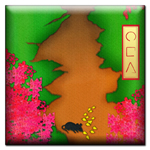On The Way: The Daily Zen Journal
Platform Sutra – Part 2
Hui-neng (638-713)

Good friends, the Dharma isn’t direct or indirect. It’s people who are sharp or dull. For those who are deluded, there is indirect persuasion. For those who are aware, there is direct cultivation: know your mind and see your nature. For those who are aware, there is basically no separation. For those who aren’t aware, there are infinite kalpas on the Wheel of Rebirth.
Good friends, since ancient times, this Dharma teaching of ours, both its direct and indirect versions, has proclaimed “no thought” as its doctrine, “no form” as its body, and “no attachment” as its foundation.
What do we mean by a form that is “no form?”
To be free of form in the presence of forms.
And “no thought?” Not to think about thoughts.
And “no attachment,” which is everyone’s basic nature?
Thought after thought, not to become attached.
Whether it’s a past thought, a present thought, or a future thought, let one thought follow another without interruption. Once a thought is interrupted, the dharma body becomes separated from the material body. When you go from one thought to another, don’t become attached to any dharma.
Once one thought becomes attached, every thought becomes attached, which is what we call “bondage.” But when you go from one thought to another without becoming attached to any dharma, there’s no bondage. This is why “no attachment” is our foundation.

Good friends, “no form” means externally to be free of all forms. If you can just be free of forms, the body of your nature is perfectly pure. This is why we take “no form” as our body.
To be unaffected by any object is what is meant by “no thought,” to be free of objects in our thoughts and not to give rise to thoughts about dharmas. But don’t think about nothing at all.
Students of the Way, take heed. Don’t misunderstand the meaning of this teaching. It’s one thing to be mistaken yourself, but quite another to lead others astray, then to criticize the teaching of the sutras while remaining unaware that you yourself are lost.
Thus, the reason we proclaim “no thought” as our doctrine is because deluded people think in terms of objects, and on the basis of these thoughts, they give rise to erroneous views. This is the origin of all afflictions and delusions.
When your nature gives rise to thoughts, even though you sense something, remain free and unaffected by the world of objects. The Vimalakirti Sutra says, “Externally, be skilled at distinguishing the attributes of dharmas, and internally, remain unshaken by the ultimate truth.”

Good friends, in this school of the Dharma, when we practice Zen, we don’t contemplate the mind, and we don’t contemplate purity, and we don’t talk about being dispassionate.
If someone says to contemplate the mind, the mind is basically a delusion, and because a delusion is the same as an illusion, there is nothing to contemplate.
If someone says to contemplate purity, your nature is already pure. It’s because of deluded thoughts that reality is obscured. But once you are free of deluded thoughts, your original nature is pure. If you don’t see that your nature is already pure, and you rouse your mind to contemplate purity, you create the delusion of purity instead.
A delusion has no actual location, which is how we know what we contemplate is a delusion. And purity has no form. If someone establishes a form for purity and thinks they have achieved something, those who hold such a view separate themselves from their own nature and become trapped by purity instead.

What do we mean in this school by “to practice Zen?” In this school, by “to practice,” we mean not to be obstructed by anything and externally, not to give rise to thoughts about objective states. And by “Zen,” we mean to see our nature without being confused.
And what do we mean by “Zen meditation?” Externally, to be free of form is “Zen.” And internally, not to be confused is “meditation.” Externally, if you attach to form, internally your mind will be confused. But if you are free of form externally, internally your nature will not be confused.
Your nature itself is pure and focused. It is just that you come into contact with objects, and as you come into contact, you become confused. When you are free of form and not confused, you are focused.
To be free of form externally is “Zen.” Not to be confused internally, is “meditation.” External Zen and internal meditation, this is what we mean by “Zen meditation.”
The Vimalakirti Sutra says, “Suddenly all at once, we return to our original mind.” And the Bodhisattva Precept Sutra says, “Our original nature is pure.”

Good friends, see the fundamental purity in your own nature. Practice for yourselves the practices of a Buddha. Begin and complete for yourselves the path to Buddhahood.
Hui-neng, Sixth Patriarch of Zen (638-713)
Excerpted from The Platform Sutra – The Zen Teaching of Hui-neng; translated by Red Pine 2006





If you could essentialize what Hui-neng is teaching here, what would it feel like? The first thing that comes to mind is a description of a life of flow. What about a life of balance where we don’t stick anywhere, but we can function here and move on?
Naturally, we have thoughts that come up almost continuously at times. The ability to let them go and make room for an openness that is constantly responsive to the ever-changing is an integral part of a life of practice.
The practice of meditation provides a time when the space between thoughts is allowed to lengthen, and we get to experience non-attachment in real time as we let the thoughts come and go.
What may present a bit of confusion is the use of the words “dharma” and “Dharma.” To clarify this distinction, think of dharma as anything that arises as a result of perception, thoughts, or experience – all the many things that can distract us.
Dharma (with an upper case “d”) refers to the teachings of the Buddha. And our communication in daily life primarily concerns dharma. Notice how things shift when we speak from a place of Dharma; it’s like we enter a more spacious room, no matter where we are in practice.
Your nature itself is pure and focused. It is just that you come into contact with objects, and as you come into contact, you become confused. When you are free of form and not confused, you are focused. To be free of form externally is “Zen.” Not to be confused internally is “meditation.”
A life of flow has a nice ring to it, and something we all feel from time to time.
Resting in the lap of the Universe,
Elana, Scribe for Daily Zen